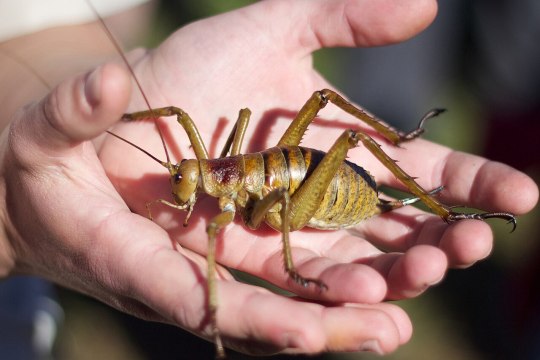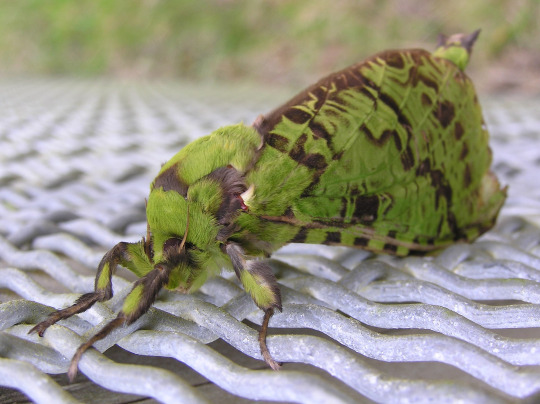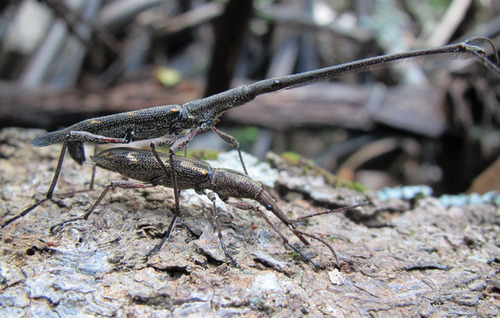#new zealand insect
Explore tagged Tumblr posts
Text
#2726 - Fam. Hydrobiosidae

Probably the Common Green Freeliving Caddisfly Hydrobiosis parumbripennis, but most of the Hydrobiosidae look very alike.
If it is that species, they live in stony streams where the first three instars are mostly detritus feeders, then switch to preying on other aquatic insects for the final two instars. The larvae of New Zealand Hydrobiosids have pincers on their forelegs.
Unlike most Caddisflies, these ones don't construct a case for their protection, probably because it would slow them down when they're hunting.
Waipiata, Aotearoa New Zealand.
#Hydrobiosis#Hydrobiosidae#Waipiata#new zealand insect#free-living caddisfly#new zealand caddisfly#caddisfly
9 notes
·
View notes
Text
The Giant Wood Moth: these rat-sized moths have a wingspan of up to 23cm (about 10 inches) and can weigh as much as 30 grams, making them the heaviest moths in the world

This species (Endoxyla cinereus) is found only in Australia and New Zealand. It has a larval stage that can last 2-3 years, and the larvae spend most of that time eating and tunneling into the wood of eucalyptus trees. Once they are finally ready to pupate, they transform their tunnel into a pupation chamber, and they eventually emerge from the chamber as adult moths.

Above: the enormous pupa of a giant wood moth
The adult moths can only survive for a few days after that; like many other lepidopterans, the adults of this species are incapable of feeding, because they do not have any functional mouthparts, so their lifespan is extremely brief. They spend their entire adult lives (which last only a matter of days) searching for a mate and reproducing. In order to accomplish that goal, they must rely on the energy afforded by the fat reserves that they accumulated when they were larvae.

Above: the adult moths
Giant wood moths display a significant degree of sexual dimorphism, as the females are roughly twice the size of the males; they can weigh up to 30 grams, which makes this the heaviest moth species in the world.
In fact, the females are so heavy that they can barely even fly. In order to find a mate, they must crawl to the top of a tree trunk or fence post, release their pheromones, and then simply wait for the males to find them.
Sources & More Info:
Australian Museum: The Giant Wood Moth
Austral Ecology: Life History, Ecology and Ethnoentomology of the Giant Wood Moth
Australian Geographic: Giant Wood Moth
Moth Identification Guide: Endoxyla cinereus
The Guardian: Giant Wood Moth: 'very heavy’ insect rarely seen by humans spotted at Australian school
#lepidoptera#entomology#moths#giant wood moth#endoxyla cinereus#arthropods#insects#bugs#australia#new zealand#animal facts#cool animals#it's like a kitten with wings
359 notes
·
View notes
Text
#good news#nature#science#environmentalism#animals#environment#conservation#bugs#insects#new zealand
1K notes
·
View notes
Note
i request the wonderful giant wētā !!
I love them!


#new zealand#new zealand animals#giant wētā#wētā#orthoptera#terrestrial invertebrate#invertiblr#bugblr#bug#bugs#insect#insects#insecta#arthropoda#animal polls#poll blog#my polls#polls#tumblr polls
93 notes
·
View notes
Text

Little Barrier Giant Weta aka Wetapunga (Deinacrida heteracantha), family Anostostomatidae, Tiritiri Matangi Island, New Zealand
photograph by Dinobass
347 notes
·
View notes
Text
New Zealand's native stoneflies have changed color in response to human-driven environmental changes, new research shows. Just published in the journal Science, the University of Otago study provides arguably the world's most clear-cut case of animal evolution in response to change made by humans. Co-author Professor Jon Waters, of the Department of Zoology, says the stonefly has become a different color due to recent deforestation.
Continue Reading.
46 notes
·
View notes
Note
are you a moth enjoyer?
YES. very much so I love those freaky beasts
as a kiwi I'm biased but one of my favourites has to be the pūriri moth!! they're endemic to Te Ika-a-Māui, Aotearoa, and they're gorgeous and the greenest things ever




the larvae live for roughly 6 years before metamorphosing, and spend most of their time burrowing in trees such as the pūriri tree. I got to see a mature pūriri tree when I visited the bird sanctuary island tiritiri matangi in december and it had so many pockmarks from pūriri moth grubs!! super cool to see [: love these beasts
169 notes
·
View notes
Text









Glow Worms | New Zealand: Earth's Mythical Islands
Gnat larvae lairs are in dark dank forest overhangs where the extreme moisture is put to good use. As night settles, the genius of their deadly traps is revealed: the bioluminescence is generated by a chemical reaction within their tail, creating an irresistible lure. The hungrier they are, the brighter they glow drawing in victims like moths to a flame.
#documentaryedit#natureedit#userdocumentary#christmasedit#bioluminescence#Glow Worms#gnats#insects#animals#🐾#gifs#🎄#PFA orig#src documentary#📺 New Zealand: Earth's Mythical Islands (2016)#narrated by Sam Neill#Nightmare Before Christmas vibe
31 notes
·
View notes
Text

A bush cricket sits on a sunflower petal in a garden in Christchurch, New Zealand. The insect is also known as a katydid, named after the sound it makes by rubbing its wings together.
Photograph: Sanka Vidanagama/NurPhoto/REX/Shutterstock
#sanka vidanagama#photographer#nurphoto#rex#shutterstock#bush cricket#cricket#insect#sunflower petal#christchurch#new zealand#nature#kadydid
21 notes
·
View notes
Text
#2564 - Microvelia macgregori

A species of Riffle Bug endemic to Aotearoa - like the species I've found here in Australia before, tiny carnivorous bugs that live on the surface of the water and converge to devour any other insects unfortunate enough to fall in. M. macgregori is the only Veliid found in New Zealand, and comes in winged and wingless forms - the former Is most common on upland tarns.
These ones were living in a tiny stagnant pond where a stream was running into Lake Rotoiti.
St Arnaud, Southern Alps, New Zealand.
9 notes
·
View notes
Text
Uncharismatic Fact of the Day
Aptly named, the New Zealand giraffe weevil is the longest beetle in Aotearoa. Males can reach a length of 90 mm (3.5 in), half of which is their elongated snout. These extraordinary appendages are used to battle for access to females, which have much shorter snouts.

(Image: A mating male (top) and female (bottom) New Zealand giraffe weevil () by Christina Painting)
If you like what I do, consider leaving a tip or buying me a ko-fi!
#new zealand giraffe weevil#Coleoptera#Brentidae#straight snouted weevils#weevils#beetles#insects#arthropods#uncharismatic facts
249 notes
·
View notes
Text
Original New Zealand legendary Pokemon
Another series of fakemon for my Goorda region, based on a combination of Australia and Aotearoa/New Zealand. This entry introduces a minor legendary trio, like the Regis or legendary birds. Links to previous posts at the bottom.

Puwetanga, the Earth Guardian Pokemon, bug/ground type. One of the three legendary Pokemon that protect Goorda's environment. What appears to be a giant insect is actually a construct made of soil, sand, and rock inhabited and animated by a colony of glowing worms. These worms are said in legend to be the very spirits of the land in physical form and they can appear in the stone and soil anywhere in Goorda to act wherever they are needed. Puwetanga is a fickle being that values the environment's safety over human life and will attack industries or settlements that cause too much damage to nature. In the past, when industry polluted the land without regard for nature, Puwetanga was an enemy of humanity. Since then, it is rarely seen, but is always watching and waiting for the time when it will be needed again.

Hinetanga, the Air Guardian Pokemon, bug/fairy type. One of the three legendary Pokemon that protect Goorda's environment. Hinetanga is one with the winds and spends its entire life in the air, continuing to fly even when asleep. Indeed, it has no legs and cold not live on land even if it wanted to. Hinetanga is the most elusive of the trio, very rarely appearing before anyone, but almost everyone in Goorda has seen evidence of its existence. As Hinetanga flies, the holes on its side release luminous gasses that clean the air and produce brilliant curtains of waving light visible at night. It avoids polluted air and will strike out against excess pollution. During the past, when industry polluted the air without care for nature, sightings of Hinetanga became so rare that many feared it had died. Since the dawn of environmentalism, sightings have increased, but it no longer appears every night like it once did.

Tanitanga, the Water Guardian Pokemon, bug/water type. One of the three legendary Pokemon that protect Goorda's environment. Tanitanga can appear in any body of water in Goorda, from the most isolated of pools to the great ocean and it is believed that it watches over the region from every raindrop. Of of its trio, Tanitanga is the most connected with humanity, though it is a fickle being that must be treated with respect. Tribes that respected the environment and left offering for Tanitanga would be protected by it, while those who disrespected the environment could be considered its enemy and attacked with floods and aquatic Pokemon. During the time when industry polluted the waters without concern for nature, Tanitanga lashed out against all peoples and refused to appear to them. Since then, it has once again began appearing to humans, but it still seems wary of us. Those who follow old traditions claim we must restore the environment to regain Tanitanga's trust.
All three of these Pokemon are based on Kaitiakitanga, a Maori concept meaning guardianship of the land, sea, and sky. This can refer to actions and duties people take, but can also refer to the role of some legendary creatures. The latter is what I went with when designing these fakemon. All three are also based on insects and other invertebrates native to Aotearoa/New Zealand.
Puwetanga is based on wētās, large flightless crickets found only in Aotearoa. More specifically, it is based on giant wētās. The glowing worms that control the wētā body are based on Arachnocampa luminosa, the New Zealand glowworms. These are cave-dewlling insect larvae that bioluminesce and dangle sticky, beaded strings that are used to attract and ensnare bugs for the worm to eat. The bead-like decorations on Puwetanga are based on the glowworm strings. Its name comes from "pūrātoke" (one of the Maori names for the glowworms), "wētā", and "Kaitiakitanga".
Hinetanga is based on moths. More specifically its wing shape and body are based on the hawk moth Agrius convolvuli while the green wing markings are based on Cosmodes elegans. The luminous gasses that Hinetanga releases are based on the southern lights. Aotearoa is one of the best places in the world to see the southern lights so I wanted to represent them with a Pokemon. Hinetanga's name comes from "Ngā Kurakura o Hinenuitepō", which is one of two Maori names I found for the southern lights.
Tanitanga is based on the Taniwha, a legendary guardian of the water in Maori legend. Depending on the tradition, the Taniwha can either be a protective guardian being or a dangerous predator that attacks people. I worked both into my fakemon. The Taniwha is usually depicted as a shark or lizard, but since this is a bug trio, I went a different way and based it on a mayfly larva. Mayfly larvae are aquatic and breathe through gills on their side. I also gave Tanitanga a crayfish's claws. Crayfish are also native to Aotearoa, but since Goorda is based on Australia too, the claws can also work as a reference to the absolutely massive crayfish that live in Tasmania.
Previous fakemon posts: New Zealand misc, new evolutions, misc 4, misc 3, single stages, non-natives, regional standards, creepy lines, regional variants, birds, early game standards, misc 2, misc 1, Johto starter variants, starters.
#fakemon#australia#aotearoa#new zealand#legendary pokemon#pokemon#original pokemon#weta#giant weta#glow worm#moth#hawk moth#southern lights#aurora australis#taniwha#mayfly#mayfly larva#aquatic insects#crayfish#maori mythology
9 notes
·
View notes
Text
A fascinating article about New Zealand’s amber fossil record, now thought to be the longest continuous one in the world.
Unfortunately, it is not suitable for dinosaur cloning purposes.
#new zealand#aotearoa#entomology#insects#amber#geology#palaeontology#paleontology#(for the Americans)#new zealand geographic
20 notes
·
View notes
Text


This animal was requested!
#asian bug#african bug#australian bug#moth#common fruit-piercing moth#caterpillar#lepidoptera#moths#bug#bugs#insect#insects#insecta#introduced to hawaii#new zealand#& the society islands#animal polls#poll blog#my polls#animals#polls#tumblr polls
45 notes
·
View notes
Text
Temporarily pinning this to remind everyone to vote for the Aotearoa Bug of the Year!!
It only takes 5 minutes (or less!) of your time and you can vote from anywhere in the world. The deadline is the 17th of February!
#aotearoa#new zealand#bugs#praying mantis#velvet worm#stick insect#springtails#weevils#spiders#mayflies#moths#moth#butterflies#butterfly#red admiral#weta#wētā#flies#blowfly#ants#insects#slugs#slug#chafer beetle#cockchafer#beetles#crickets#snails#giant snail#mantids
4 notes
·
View notes
Text

Chalcid Wasp (genus Pseudoceraphron), wingless female, Kaeo, New Zealand
I couldn't find much info on the wasps in this genus, but they tend to be very tiny. Many of the species in this family (Chalcidae) are parasitoids or hyperparasitoids.
photograph by flossiepip | inaturalist
37 notes
·
View notes